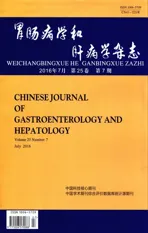美沙拉嗪对溃疡性结肠炎大鼠结肠组织TLR4表达的影响
2016-06-21彭芊芊
彭芊芊,赵 彤
南方医科大学第三附属医院 1.消化内科; 2.病理科,广东 广州 510095
美沙拉嗪对溃疡性结肠炎大鼠结肠组织TLR4表达的影响
彭芊芊1,赵 彤2
南方医科大学第三附属医院 1.消化内科; 2.病理科,广东 广州 510095
目的 探讨美沙拉嗪对溃疡性结肠炎(ulcerative colitis, UC)大鼠结肠组织 TLR4表达的影响。方法 选取30只SD大鼠随机分为正常对照组、UC组及治疗组。后两组均采用三硝基苯磺酸(TNBS)诱导制备UC大鼠模型。成功建模2 d后,治疗组采用美沙拉嗪+蒸馏水混悬液3 ml 灌胃,正常对照组、UC组仅用单纯蒸馏水3 ml 灌胃,连续灌注14 d后,处死三组大鼠,对三组大鼠的疾病活动指数、肠黏膜及组织学损伤进行评估,RT-PCR反应测定结肠组织TLR4 mRNA的表达;蛋白质印迹法测定 TLR4蛋白的表达。结果 UC组大鼠疾病活动指数、肠黏膜及组织学损伤评分均显著高于正常对照组和治疗组 (P<0.05)。UC组及治疗组大鼠结肠组织TLR4 mRNA及蛋白表达水平显著高于正常对照组(P<0.05)。与UC组比较,治疗组大鼠结肠组织TLR4 mRNA及蛋白表达均显著降低,差异有统计学意义(P<0.05)。结论 美沙拉嗪对UC大鼠结肠组织 TLR4表达有抑制作用,可有效减少肠组织TLR4 mRNA的表达,缓解UC大鼠结肠组织损伤,有效保护UC大鼠结肠组织黏膜。
美沙拉嗪;溃疡性结肠炎;大鼠结肠组织;TLR4
近年溃疡性结肠炎(ulcerative colitis, UC)的发病率逐年上升,其临床表现以反复发作的慢性炎症为特点,具体发病机制不明[1]。目前研究[2]表明, UC的发病与遗传、环境、免疫等多种因素相关,免疫因素是近年的研究热点,Toll 样受体4 (Toll like receptor 4,TLR4)被认为是促进UC发病的重要表达免疫因素[2]。文献[3]报道,UC大鼠结肠黏膜中TLR4蛋白表达明显高于正常值,UC患者肠道黏膜TLR2及TLR4表达均增加。美沙拉嗪是治疗UC疗效良好的新型5-氨基水杨酸控释剂,且目前未报道出现明显的不良反应[4]。本研究探讨应用美沙拉嗪对UC大鼠结肠组织 TLR4表达的影响,现将结果报道如下。
1 材料与方法
1.1 实验动物及材料 健康成年SD 大鼠30 只,雄性17只,雌性13只,体质量(195±5)g。主要试剂:三硝基苯磺酸(TNBS)购自Sigma 公司,美沙拉嗪、抗体购自SANTA CRUZ 公司,引物由上海生物工程公司合成。
1.2 研究方法
1.2.1 建模:将30只SD大鼠随机分为正常对照组、UC组及治疗组,每组各10只,后两组均采用TNBS诱导制备UC大鼠模型。具体方法:将两组大鼠禁食24 h,刺激诱导其排便,腹腔麻醉后,将润滑后的大鼠灌胃针插入肠道直接进行结肠灌注,按100 mg/kg TNBS灌注足量后,提起大鼠倒立5 min,正常对照组按相同的办法灌注等量的蒸馏水。成功建模2 d后,治疗组采用美沙拉嗪+蒸馏水混悬液3 ml 灌胃,正常对照组、UC组仅用单纯蒸馏水3 ml 灌胃,连续灌注14 d 后,处死三组大鼠,采集标本。
1.2.2 疾病活动指数、肠黏膜及组织学损伤评分:按DAI评分对三组大鼠一般情况进行评分。处死大鼠后,取出结肠组织,剖开肠系膜缘,用冰生理盐水漂洗,按CMDI评分[5]评估其肠黏膜损伤。将结肠组织制成石蜡切片,进行HE染色后,按TDI评分[6]评估其组织学损伤。采用RT-PCR反应测定结肠组织TLR4 mRNA表达;蛋白质印迹法测定结肠组织 TLR4蛋白表达。

2 结果
2.1 大鼠一般情况评分 正常对照组大鼠活动正常,体毛光滑,反应灵活有力,体质量增加,粪便正常成形。UC组及治疗组在建模成功2 d后出现不同的精神萎靡、懒动、厌食,体毛色泽暗淡无光,反应迟钝,体质量减轻,排便异常,且伴有血便、黏液便。治疗组采用美沙拉嗪治疗后,情况好转,粪便在5 d后开始成形,不再伴有血便、黏液便。实验过程中无大鼠死亡。
2.2 三组大鼠的疾病活动指数、肠黏膜及组织学损伤评分 正常对照组大鼠结肠黏膜色泽正常,未出现充血水肿,无溃烂及溃疡产生。UC组大鼠结肠出现扩张水肿,正常肠黏膜皱襞消失,有充血水肿产生,伴有溃烂及溃疡。治疗组大鼠结肠病变轻于UC组大鼠,仅有局部充血水肿,无明显肠道水肿扩张,未见明显溃烂及溃疡。UC组大鼠疾病活动指数、肠黏膜及组织学损伤评分均显著高于正常对照组和治疗组,差异有统计学意义(P<0.05,见表1)。病理结果显示,正常对照组大鼠结肠形态结构正常, 无黏膜坏死及炎症。UC组大鼠有部分黏膜坏死脱落,局部炎性细胞浸润,且有明显黏膜水肿,伴有隐窝脓肿。治疗组大鼠结肠黏膜未见明显溃疡或已经愈合,炎症浸润减轻(见图1)。
2.3 三组大鼠结肠组织TLR4 mRNA及蛋白表达水平 UC组及治疗组大鼠结肠组织TLR4 mRNA及蛋白表达水平显著高于正常对照组,差异有统计学意义(P<0.05)。与UC组比较,治疗组大鼠结肠组织TLR4 mRNA表达及蛋白表达均显著降低,差异有统计学意义(P<0.05,见表2、图2) 。



组别只数疾病活动指数组织学损伤评分肠黏膜损伤评分正常对照组1000.22±0.460.31±0.39 UC组104.60±1.11*6.31±1.98*5.48±1.81*治疗组102.20±0.72*△2.56±1.29*△2.39±1.38*△
注:与正常对照组比较,*P<0.05;与UC组比较,△P<0.05。

图1 三组大鼠病理组织切片(400×) A:正常对照组;B:UC组;C:治疗组Fig 1 Biopsy of SD rats in three groups (400×) A: normal control group; B: UC group; C: treatment group


组别只数TLR4mRNATLR4蛋白正常对照组100.09±0.020.36±0.31UC组100.34±0.01*1.53±0.36*治疗组10 0.24±0.01*△ 0.79±0.31*△
注:与正常对照组比较,*P<0.05;与UC组比较,△P<0.05。

图2 三组大鼠TLR4蛋白印迹图 A:正常对照组;B:UC组;C:治疗组
Fig 2 Western blotting of TLR4 protein in three groups
A: normal control group; B: UC group; C: treatment group
3 讨论
UC是肠道慢性非特异性疾病,目前认为其发病主要与免疫因子介导的机体综合反应有关,此外还涉及遗传、感染、环境等多方面因素,细胞因子在其发病中扮演重要角色[7]。美沙拉嗪通过清除大鼠体内肠道的氧自由基,抑制减少其结肠黏膜代谢的脂肪酸氧化,从而维持肠道黏膜屏障,减少其上皮由于局部炎症增加的通透性,从而减少局部炎症因子聚集导致的炎症细胞浸润,减轻UC严重程度[8]。TLR是机体肠道重要的病原相关模式受体,在机体免疫系统激活介导的反应中发挥着重要作用,细菌代谢产物往往通过激活跨膜TLR、通过MyD88 途径及非MyD88 依赖途径诱导炎症介质的产生及聚集,积极参加免疫应答,引起诱发的机体免疫及防御系统过度激活,体内释放大量炎症因子,如TNF-α、IL-6、IL-8等,最终形成逐级放大瀑布式炎症反应综合征及多器官功能衰竭[9]。正常机体存在免疫耐受应对免疫激活,避免产生免疫疾病损伤,但文献[10]报道, 重症肺炎导致心肌损伤或败血症等疾病中,内皮细胞对于内毒素耐受消失,通过TLR4 信号传导通路介导炎症因子的产生,导致级联炎症反应。廖奕等[11]研究发现,UC结肠黏膜中TLR4 mRNA及蛋白表达水平均显著升高,提示其对于UC发病及病情进展起重要作用。
本研究结果表明,UC组大鼠疾病活动指数、肠黏膜损伤评分及组织学损伤评分均显著高于正常对照组和治疗组。UC组及治疗组大鼠结肠组织TLR4 mRNA及蛋白表达水平显著高于正常对照组。与UC组比较,治疗组大鼠结肠组织TLR4 mRNA及蛋白表达均显著降低。说明美沙拉嗪对UC大鼠结肠组织 TLR4表达有抑制作用,可有效减少结肠组织TLR4 mRNA的表达,缓解UC大鼠肠道扩张充血水肿,减轻其溃疡及糜烂,达到良好的治疗效果。本研究结果与罗南等[12]结果近似。
[1]Teng X, Xu LF, Zhou P, et al. Effects of trefoil peptide 3 on expression of TNF-alpha, TLR4, and NF-kappaB in trinitrobenzene sulphonic acid induced colitis mice [J]. Inflammation, 2009, 32(2): 120-129.
[2]Monteleone G, Biancone L, Marasco R, et al. Interleukin 12 is expressedand actively released by Crohn’s disease intestinal lamina propriamononuclear cells [J]. Gastroenterology, 2012, 112(4): 1169.
[3]Niessner M, Volk BA. Altered Th1/Th2 cytokine profiles in the intestinal mucosa of patients with inflammatory bowel disease as assessed by quantitative reversed transcribed polymerase chain reaction (RT-PCR) [J]. Clin Exp Immunol, 2011, 101(3): 428.
[4]Yamaguchi T, Soma T, Takaku Y, et al. Salbutamol modulates the balance of Th1 and Th2 cytokines by mononuclear cells from allergic asthmatics [J]. Int Arch Allergy Immunol, 2010, 152 Suppl 1: 32-40.
[5]Cooper HS, Murthy SN,Shah RS, et al. Clinicopathologic study of dextran sulfate sodium experimental murine colitis [J]. Lab Invest, 2013, 69(2): 238-249.
[6]Obermeier F, Dunger N, Strauch UG, et al. Contrasting activity of cytosin-guanosin dinucleotide oligonucleotides in mice with experimental colitis [J]. Clin Exp Immunol, 2003, 134(2): 217-224.
[7]Greenhill CJ, Rose-John S, Lissilaa R, et al. IL-6 trans-signaling modulates TLR4-dependent inflammatory responses via STAT3 [J]. J Immunol, 2013, 186(2): 1199-1208.
[8]Putra AB, Nishi K, Shiraishi R, et al. Jellyfish collagen stimulates production of TNF-α and IL-6 by J774.1 cells through activation of NF-κB and JNK via TLR4 signaling pathway [J]. Mol Immunol, 2014, 58(1): 32-37.
[9]Wang WM, Deng MJ, Liu XT, et al. TLR4 activation induces nontolerant inflammatory response in Eendothelial cells [J]. Inflammation, 2013, 34(6): 509-518.
[10] Szebeni B, Veres G, Dezsofi A, et al. Increased expression of Toll- like receptor (TLR)2 and TLR4 in the colonic mucosa of children with inflammatory bowel disease [J]. Clin Exp Immunol, 2012, 151(1): 34-41.
[11] 廖奕, 范恒, 陈小艳, 等. β-arrestin1在实验性大鼠结肠炎发生机制中的作用及氧化苦参碱的干预作用[J]. 中国中西医结合杂志, 2012, 30(10): 1067-1072.
Liao Y, Fan H, Chen XY, et al. Pathogenetic mechanism of β-arrestin1 in experimental colitis of rats and intervention effects of oxymatrine [J]. CJITWM, 2012, 30(10): 1067-1072.
[12]罗南, 颜玉. 美沙拉嗪对大鼠溃疡性结肠炎NF-κB和TGF-β表达的影响[J]. 黑龙江医药科学, 2012, 33(4): 11-12.
Luo N, Yan Y. Effect of Mesalazine on NF-κB and TGF-β expression in ulcerative colitis [J]. Heilongjiang Medicine and Pharmacy, 2012, 33(4): 11-12.
(责任编辑:王豪勋)
Effect of Mesalazine on the expression of TLR4 in colonic tissue of ulcerative colitis rats
PENG Qianqian1, ZHAO Tong2
1.Department of Gastroenterology; 2.Department of Pathology, the Third Affiliated Hospital of Southern Medical University, Guangzhou 510095, China
Objective To investigate the effect of Mesalazine on the expression of TLR4 in colonic tissue of ulcerative colitis (UC) rats. Methods Thirty SD rats were randomly divided into normal control group, UC group and treatment group. TNBS was used to induce UC rat model in UC group and treatment group. Two days after the successful model, the treatment group was treated with Mesalazine plus distilled water suspension gavage 3 ml; normal control group and UC group were treated with distilled water gavage 3 ml, SD rats of three groups were killed after 14 days treatment. Disease activity index, the intestinal mucosa injury and histological injury were evaluated. TLR4 mRNA was detected by RT-PCR; TLR4 protein was detected by Western blotting. Results The disease activity index, histological injury score and intestinal mucosa injury score in UC group were significantly higher than those in the normal control group and treatment group (P<0.05). Expressions of TLR4 mRNA and protein in UC group and treatment group were significantly higher than those in the normal control group (P<0.05). Compared with the UC group, the expressions of TLR4 mRNA and protein in treatment group were decreased, and there was significant difference between two groups (P<0.05).Conclusion Mesalazine can inhibit TLR4 expression in UC rats, can effectively reduce the expression of TLR4 mRNA in intestinal tissue, and relieve the damage of colonic tissue of UC rats.
Mesalazine; Ulcerative colitis; Colonic tissue of rats; Toll like receptor 4
10.3969/j.issn.1006-5709.2016.07.007
论著·炎症性肠病
R574.62
A
1006-5709(2016)07-0742-03
2015-10-16
